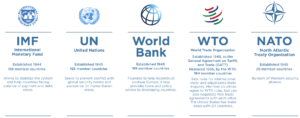Following is an excerpt from an interactive website published by the Peterson Institute of International Economics. To view the full site, please click here.
After centuries of technological progress and advances in international cooperation, the world is more connected than ever. But how much has the rise of trade and the modern global economy helped or hurt American businesses, workers, and consumers? Here is a basic guide to the economic side of this broad and much debated topic, drawn from current research
Globalization is the word used to describe the growing interdependence of the world’s economies, cultures, and populations, brought about by cross-border trade in goods and services, technology, and flows of investment, people, and information. Countries have built economic partnerships to facilitate these movements over many centuries. But the term gained popularity after the Cold War in the early 1990s, as these cooperative arrangements shaped modern everyday life. This guide uses the term more narrowly to refer to international trade and investment among advanced economies, mostly focusing on the United States.
The wide-ranging effects of globalization are complex and politically charged. As with major technological advances, globalization benefits society as a whole, while harming certain groups. Understanding the relative costs and benefits can pave the way for alleviating problems while sustaining the wider payoffs.
THE HISTORY OF GLOBALIZATION IS DRIVEN BY TECHNOLOGY, TRANSPORTATION, AND INTERNATIONAL COOPERATION
Since ancient times, humans have sought distant places to settle, produce, and exchange goods enabled by improvements in technology and transportation. But not until the 19th century did global integration take off. Following centuries of European colonization and trade activity, that first “wave” of globalization was propelled by steamships, railroads, the telegraph, and other breakthroughs, and also by increasing economic cooperation among countries. The globalization trend eventually waned and crashed in the catastrophe of World War I, followed by postwar protectionism, the Great Depression, and World War II. After World War II in the mid-1940s, the United States led efforts to revive international trade and investment under negotiated ground rules, starting a second wave of globalization, which remains ongoing, though buffeted by periodic downturns and mounting political scrutiny.
GLOBALIZATION AS A TOOL FOR PROSPERITY AND PEACE
After World War II, the United States helped build a global economic order governed by mutually accepted rules and overseen by multilateral institutions. The idea was to create a better world with countries seeking to cooperate with one another to promote prosperity and peace. Free trade and the rule of law were mainstays of the system, helping to prevent most economic disputes from escalating into larger conflicts. The institutions established include:

EFFECTS OF GLOBALIZATION
To view the interactive publication by Peterson Institute for International Economics, click here
© 2018, Peterson Institute for International Economics

